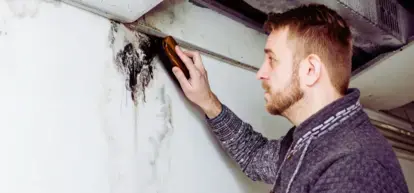
Mold in Your Air Ducts? Here’s How to Remove It for Good
Contact COIT for a professional cleaning!
If you’ve been noticing musty odors, unexplained allergy symptoms, or black streaks around your vents, you might have a serious mold problem hiding in your air ducts.
Finding black mold in your air vents is more than just an annoyance—it can actually be toxic and impact your health every time your HVAC system runs. Mold spores travel through the air, spreading contamination throughout your home, and the longer you wait, the worse the problem gets.
In this guide, we’ll cover how to identify black mold in air vents, its health effects, and the best ways to both remove and prevent it.
As cleaning professionals at COIT, we’ve seen firsthand how dangerous mold growth can be. Here’s what you need to know:
Signs of Black Mold in Air Ducts
Black mold (Stachybotrys chartarum) thrives in damp, humid environments—making HVAC systems and ductwork a prime breeding ground. Here’s how to tell if you have mold in your air vents:
1. Visible Mold Growth
- Black, green, or brown spots or streaks around vents or inside ducts
- Fuzzy or slimy texture on surfaces
- Recurring mold growth after cleaning
2. Musty or Moldy Odors
- Persistent earthy or damp smells coming from air vents
- Stronger odor when the HVAC system is running
3. Increased Allergy Symptoms
- Sneezing, coughing, and congestion
- Itchy, red, or watery eyes
- Sore throat or irritated sinuses
4. Respiratory Issues & Severe Reactions
- Shortness of breath or wheezing
- Chronic headaches or dizziness
- Long-term exposure can cause lung infections, internal bleeding, and neurological problems
5. Excess Moisture & Condensation
- Water stains around vents
- Condensation forming on or inside ductwork
- High humidity levels in your home
If you notice one or more of these signs, it’s time to take action. Contact COIT for a professional cleaning today.
What Causes Black Mold to Grow in Air Ducts?
Mold needs three things to grow: moisture, warmth, and organic material. And guess what? Your air ducts provide all three under the right conditions.
- Humidity & Moisture: Leaks, condensation, or high indoor humidity (above 60%) encourage mold growth.
- Dust & Organic Debris: Mold feeds on dust, pet dander, and household debris inside your ductwork.
- Poor Ventilation: Inadequate airflow creates stagnant air pockets where mold thrives.
- Dirty Air Filters: Clogged or old filters allow mold spores to circulate.
- Leaky Ducts: Air leaks can introduce moisture into the system, encouraging mold growth.
How to Get Rid of Black Mold in Air Vents
Removing black mold from air ducts is not a DIY job—it requires specialized tools and professional-grade cleaning solutions.
Here’s what the process looks like when its done correctly:
Step 1: Professional Inspection & Testing
A mold remediation expert will:
- Visually inspect your vents and ductwork for mold growth
- Use moisture meters to check humidity levels inside your system
- Perform air quality tests to detect airborne mold spores
- Identify the source of the moisture problem to prevent regrowth
Step 2: Containment to Prevent Mold Spread
Before cleaning starts, professionals will seal off affected areas to prevent mold spores from spreading to other parts of your home.
Step 3: HEPA Vacuuming & Scrubbing
- High-Efficiency Particulate Air (HEPA) vacuums remove loose mold spores and debris.
- Motorized brushes & agitation devices scrub duct surfaces to dislodge stubborn mold growth.
Step 4: Eco-Friendly Mold Removal Treatment
- Professional mold-killing agents (non-toxic and EPA-approved) are applied to remove mold at its root.
- Fogging or antimicrobial sealants may be used to prevent regrowth.
Step 5: Air Scrubbing & Filtration
- HEPA air scrubbers remove lingering airborne mold spores.
- Your system is flushed with fresh, clean air to improve indoor air quality.
Once the ducts are cleaned, professionals will then address the root cause of the problem (leaks, humidity, poor ventilation) to make sure mold doesn’t return.
How to Prevent Mold in Your Air Vents
Prevention is key to avoiding costly mold remediation. Here’s what you can do to help keep mold from forming in your ducts:
Control Indoor Humidity
Mold loves moisture, so keeping your home’s humidity levels in check is key. Ideally, indoor humidity should stay below 50%—you can use a dehumidifier to help with this. Ventilating moisture-prone areas like bathrooms, kitchens, and laundry rooms also helps keep humidity under control.
Change Your Air Filters Regularly
Your air filter is your first line of defense against mold spores. HEPA filters trap mold spores and prevent them from circulating in your home. Just make sure to replace your air filters every 1-3 months, or even more frequently if you have pets or allergies.
Schedule Regular HVAC Maintenance
Just like your car needs routine oil changes, your HVAC system needs regular checkups. Professional air duct cleaning every 2-3 years helps prevent mold growth. If you live in a humid climate or have allergies, annual maintenance is even more important. During these cleanings, professionals should also check your drain pans, coils, and ductwork for mold and leaks.
Install UV Light Purifiers
Want an extra layer of protection? UV-C light purifiers installed inside your HVAC system can kill mold spores before they spread. They’re a great long-term mold prevention strategy.
Keep Your Vents & Registers Clean
Regular dusting and vacuuming around your vents can help prevent mold spores from settling in. Also, be mindful not to block your vents with furniture or objects—this can trap moisture and create the perfect mold-friendly environment.
Common Myths About Mold in Air Ducts
1. “Mold in air vents isn’t dangerous.”
False. Even non-toxic mold can trigger allergies and respiratory issues. Black mold is especially harmful due to its toxic mycotoxins.
2. “I can clean black mold myself.”
False. DIY cleaning only removes surface mold—it doesn’t eliminate spores deep inside the ductwork. Professional cleaning is the only way to fully remove mold.
3. “Once mold is removed, it won’t come back.”
False. Without fixing the moisture problem, mold will regrow. That’s why humidity control and preventative maintenance are so important.
Why Choose COIT for Mold Removal?
At COIT, we specialize in air duct cleaning and mold remediation with industry-leading equipment and certified technicians. Here’s what sets us apart:
✔ Advanced HEPA vacuums & motorized brushes to remove deep-set mold growth
✔ Eco-friendly, non-toxic cleaning solutions safe for your family
✔ UV light & antimicrobial treatments to prevent mold from coming back
✔ Air quality testing & post-cleaning inspections to ensure a mold-free home
✔ 100% satisfaction guarantee – we stand by our work
Don’t let mold in your air ducts put your health at risk. If you suspect mold in your HVAC system, call COIT today for a professional inspection and deep cleaning. We’ll help you breathe easier with fresh, clean air in your home.



